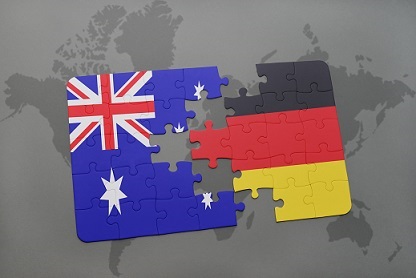
My name is Christina and I am doing my PhD within the Bo&MeRanG program at the Universities of Bonn and Melbourne. Bonn and Melbourne, that is not an easy commute some people might think. True! But it is not as if I had to travel back and forth every week. In fact, I came to Melbourne twice and stayed there altogether for one year. The remaining two years of this three-year PhD program I spent in Bonn. I agree it does sound slightly stressful but with this article I would like to point out why it did make a lot of sense in my case.
I am working on extracellular vesicles (EVs), which are – just as the term says – membranous particles released by various different cells to the extracellular space. They basically come in three different flavours, depending on what cellular compartment they are derived from: the smallest EVs are called exosomes and they are derived from an endosomal structure, EVs of intermediate size are called ectosomes or microvesicles and they are directly shed from the cell’s plasma membrane and finally there are so-called apoptotic bodies, which are the largest EVs and are derived from dying cells. All those vesicles are particularly fascinating because, besides proteins and lipids, they also contain various nucleic acids, such as miRNAs and mRNAs, which can be transferred to neighbouring cells and impact their expression profile. This makes EVs an important and rather novel mediator of cell-to-cell communication.
I am particularly interested in EVs that are released upon the encounter of danger signals, which ultimately culminate in the activation of the NLRP3 inflammasome. The aim for my PhD project is to characterise their contents and subsequently their impact on bystander cells, which could either lead to an amplified or dampened inflammatory response.
Since no one in the lab in Bonn or Melbourne had worked with EVs before, as a first step, it was necessary to establish methods and protocols for their isolation and analysis. Due to EVs being a lot smaller than cells, this was a challenging and time-consuming task I performed in Bonn in Eicke Latz’s lab. Once satisfied with the results, I went on to look closely into release kinetics and finally the RNA content of the vesicles. Therefore, cells were stimulated with a wide panel of NLRP3 activators and respective controls and EVs released were subsequently isolated from the tissue culture media and subjected to RNA isolation. We performed a transcriptome-wide microarray with those RNA samples. When the raw data of that experiment became available in the beginning of my second year, I went to Melbourne to Paul Hertzog’s lab. The idea was to learn how to program, to be able to perform the bioinformatic analysis myself. It was an awesome opportunity, not only to get to know an entirely foreign continent, but predominantly to get insights into bioinformatics and the programming language R. This is an incredibly valuable skill, as the analysis, rather than the generation, of huge data sets is the rate-limiting step nowadays. I was very lucky to be taken care of by a well-experienced bioinformatician, who patiently introduced me to the analysis procedure – I had never needed to read or write any code in my life before!
Four months later, I came back to the wet lab in Bonn to validate some of the results obtained and design new experiments focusing on gene expression changes of cells that had received and taken up some of the previously characterised EVs. Simultaneously, I optimised the EV isolation procedure further to isolate them not only out of tissue culture media but also out of human blood. This enabled me to perform a study with EVs of CAPS (Cryopyrin-associated periodic syndromes) patients, i.e. people with a constitutively hyperactive NLRP3 inflammasome, and compare their RNA content with the RNA content of in vitro-released EVs. Once all those samples were generated and shipped to be sequenced, I came to Melbourne the second time.
Here, I am analysing the data sets to identify specific changes in gene expression between cells treated with “my” EVs compared to untreated cells. Subsequently, those changes after EV transfer will be integrated with the EV content itself, to find out which factors in the EVs could be responsible for the effect observed. This will of course require further experimental validation, which I will take care of once I am back in Bonn again.
In my eyes, this PhD program is a unique opportunity to not only get thorough insights into two different countries and two different labs, but also to have the chance to work within two very different fields which are still connected by the project itself: performing wet lab experiments in one place, while learning how to deal with enormous data sets, how to analyse and interpret them in the other.
Especially when there are two supervisors in two far apart places involved, the danger of a lack of focus and thereby becoming lost within one’s own project is even higher than in a PhD conducted in one single place. Thanks to the rather strict guidelines of the Bo&MeRanG program, such as how much time to spend in each place, a pre-defined thesis submission date and regular mandatory progress updates with the entire thesis committee, this danger was kept relatively low. Without this graduate school, such a close cooperation would not have been possible. I consider myself very lucky that I got the chance to participate in this exchange.
Author: Christina Budden
